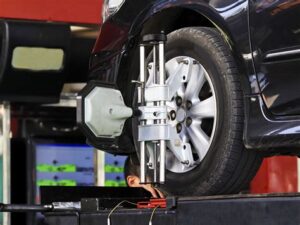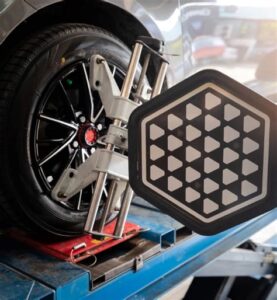Discover common signs of tire issues, including uneven wear, pulling, crooked steering, vibrations, and squealing sounds, to ensure safe and smooth driving.As a car owner, understanding the signs that indicate your vehicle may need alignment is crucial for maintaining its performance and ensuring your safety on the road. Misalignment can lead to uneven tire wear, reduced fuel efficiency, and compromised handling, ultimately affecting your driving experience. In this blog post, we will explore the key symptoms that suggest it might be time for an alignment check. From the telltale signs of uneven tire wear and your car pulling to one side to the discomfort of vibrations in the steering wheel, we’ll help you identify potential issues before they escalate into costly repairs. Whether you’re experiencing a crooked steering wheel or unsettling squealing sounds when turning, recognizing these signs early can save you time, money, and stress. Let’s dive in and empower you with the knowledge to keep your vehicle running smoothly.
Uneven tire wear
One of the most common signs that your car needs alignment is uneven tire wear. When your vehicle’s wheels are not aligned properly, it can lead to uneven contact with the road surface. This means that certain areas of your tire tread will wear down faster than others, which can greatly reduce the lifespan of your tires.
To check for uneven tire wear, visually inspect your tires for signs of wear patterns. Look for issues such as:
- Wear on the inside or outside edges – This often indicates that your tires are out of alignment.
- Center wear – This might mean that your tires are overinflated.
- Scalloping – If your tires have a wavy pattern across the tread, it could indicate a suspension issue.
If you notice any of these signs, it’s essential to have your alignment checked as soon as possible. Taking immediate action can save you money on premature tire replacements and enhance your vehicle’s safety and handling performance.
Car pulling to one side
One of the most noticeable signs that your car may need alignment is if it starts pulling to one side while driving. This issue can be distracting and dangerous, affecting not just your vehicle’s handling, but also your safety on the road. Understanding the causes behind this phenomenon can help you take timely action.
When your car pulls to one side, it can be attributed to several factors, including improperly inflated tires, uneven tire wear, or misaligned wheels. It’s important to inspect your tires regularly and ensure they are evenly inflated. If your tires have uneven wear patterns, it could indicate alignment issues that need to be addressed promptly.
Ignoring the pulling sensation can lead to further damage, such as excessive wear on suspension components. If you find yourself consistently adjusting the steering wheel to keep the car straight, it’s a clear signal that a wheel alignment is necessary. Regular checks can save you money in the long run by prolonging the life of your tires and ensuring a safer driving experience.
Crooked steering wheel
If you notice that your steering wheel is crooked when driving straight, it may be a clear indication that your car needs alignment. This issue can affect your driving experience, making it not only uncomfortable but potentially dangerous as well. A crooked steering wheel often arises due to improper alignment or worn-out suspension components.
Here are some signs to look for when determining if your steering wheel is crooked:
- Steering wheel position: When driving on a straight road, if the steering wheel is off-center, it indicates that the alignment is off.
- Tire wear: Uneven or accelerated tire wear can be a result of misalignment, which may contribute to the crooked steering wheel.
- Driving experience: If you find yourself constantly adjusting your wheel to keep the vehicle straight, this is a signal that it may require professional inspection.
If you’re facing this issue, it’s advisable to take your vehicle to a qualified technician. They can perform a full alignment and adjust the wheels to the manufacturer’s specifications. Addressing a crooked steering wheel promptly can help prevent further damage to your tires and suspension system.
Vibrations in the steering wheel
Experiencing vibrations in the steering wheel can be a disconcerting experience for any driver. It often signals potential issues with your vehicle that may require immediate attention. One of the most common causes for these vibrations is related to your car’s alignment and balance.
If your vehicle’s wheels are misaligned or if there is uneven tire wear, this can lead to a noticeable shaking or vibrating sensation in the steering wheel. As a result, driving can become uncomfortable and can even affect your ability to control the vehicle. Over time, this can also lead to more significant wear on your tires and other suspension components.
Additionally, vibrations can be caused by issues unrelated to alignment. For example, unbalanced tires, damaged suspension parts, or even the need for a tire rotation can trigger similar symptoms. Therefore, it’s crucial to inspect your vehicle thoroughly if you notice any unusual vibrations
Squealing tires when turning
Experiencing squealing tires when turning can be a distressing sound for any driver. This noise typically occurs when the tires lose traction or when they’re rubbing against another surface. It’s crucial to address the issue promptly, as it not only affects the driving experience but also can indicate underlying problems with your vehicle’s alignment.
One common reason for squealing tires during turns is worn-out or inadequate tread depth. Tires that are balding or have uneven wear are more likely to skid when making sharp turns, creating that infamous squealing sound. Regularly checking the tread depth of your tires can help prevent this issue.
Another factor to consider is your steering alignment. Misalignment can lead to uneven pressure on the tires while turning, causing them to squeal. If you notice this sound frequently, it might be an indication that your car needs a professional alignment check. Keeping your wheel alignment in proper condition not only reduces tire noise but also promotes longer tire life.
Frequently Asked Questions
What are the symptoms of a car that needs alignment?
Common symptoms include uneven tire wear, the steering wheel being off-center when driving straight, the car pulling to one side, or excessive vibration in the steering wheel.
How often should I check my car’s alignment?
It’s recommended to check your car’s alignment at least once a year or anytime you notice unusual wear on your tires or change in handling.
Can misalignment affect fuel efficiency?
Yes, misalignment can increase tire drag, which can lead to poorer fuel efficiency and increased fuel consumption.
What causes a car to go out of alignment?
Common causes of misalignment include hitting a pothole, driving over speed bumps too quickly, or a collision with another vehicle.
Is it safe to drive a car that is out of alignment?
Driving a car that is out of alignment can be unsafe, as it can affect handling and increase the risk of tire blowouts or accidents.
How much does it typically cost to get a car aligned?
The cost of a wheel alignment typically ranges from $50 to $100, depending on the shop and the specific services included.
Can I fix alignment issues myself?
While minor adjustments can sometimes be made with DIY tools, it’s generally best to have alignment checked and repaired by a professional to ensure accuracy and safety.





